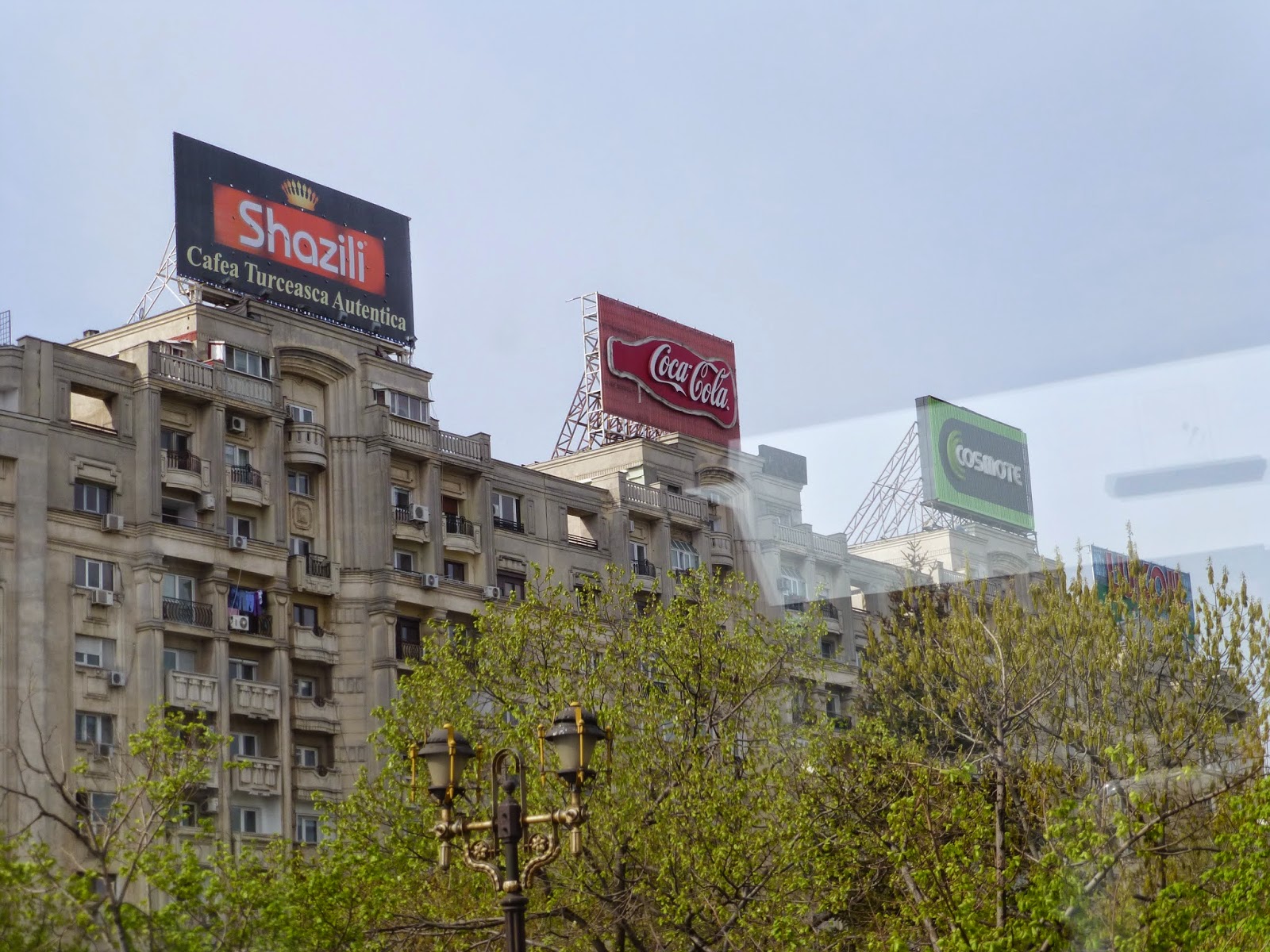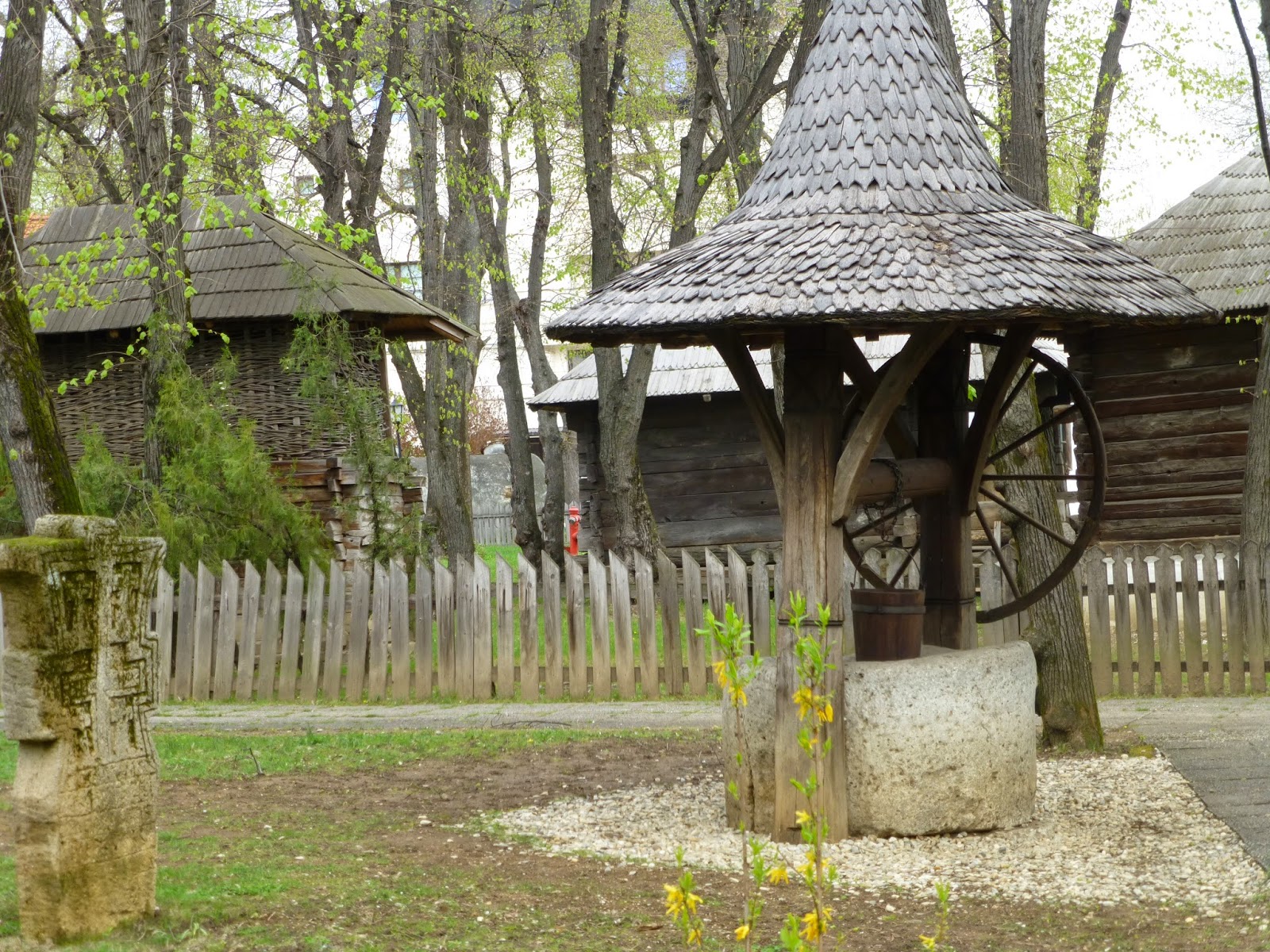As you can see on the map, Romania is just above Bulgaria, with the Danube River between. During the last few days of our cruise, we could see Bulgaria on one side of the river and Romania on the opposite side. Our final stop was in Bucharest, Romania.
Early in the morning on our last cruise day, our ship docked at Giurgiu. These were my first glimpses of Romania:
When I looked out our window, I saw a few people walking around and a couple of men fishing. There wasn't much happening here on this drizzly morning.
There was a little family of mama and puppies on the street:
Then we got on our bus and drove to the capital city of Bucharest.
Our guide told us this odd-looking house belongs to Roma people (Gypsies).
These apartment buildings are left from the Communist era. Along the way, our guides often pointed out to us the "clunky" buildings imposed on them during Soviet era. In this instance, the city was trying to make them look a little less glum by painting them bright colors. (I'm not sure I would have chosen this color, though.)
More of the "clunky" buildings from the Soviet era (not, to my mind, made more attractive by billboards atop). The fountains are on Union Square, with the clunky buildings in the background.
Perhaps the biggest, clunkiest Soviet era building of all: the Palace of the Parliament, also called the House of the People.
The Palace of the Parliament is the second largest building on Earth, second only to the United States Pentagon. I found the photo below on Google that shows how huge it is. This building is not liked by most people in Bucharest; it has been called a "monstrosity". Its history is an example of one man's grandiose ambitions and lack of concern for the people. It was built at the orders of Nicolae Ceausescu (I learned to pronounce it "chow-chess-cue"). He was the Communist dictator of Romania from 1967 to 1989. In order to build his trophy, he destroyed the historic center of Bucharest, eliminating 26 churches and throwing 40,000 people out of their 19th century homes. The people were removed to the clunky Soviet apartment buildings.
In 1989 the people revolted and Ceausescu and his wife were executed. The revolution is commemorated on Revolution Square, which we drove by:
The pillar in the middle of Revolution Square is called the Memorial of Rebirth. It stands in front of the building that formerly served as the Romanian Communist Party's Central Committee. On the square there is also a wall inscribed with names of those killed in the revolution in 1989.
Also facing Revolution Square is the Central University Library. The statue in front of the library represents King Carol the 1st of Romania.
There is a lot of Bucharest that we did not have the chance to see. This was the last day of our tour so we had limited time. Also, we experienced a big-time traffic jam in the middle of the city. These are the photos I was able to take from my bus window.
A bit of irony: this sign says "do not block the intersection". Actually, all the intersections were blocked that day.
I noticed the license plates in the European Union countries had the EU flag with the name of the country. I also noticed someone had had Picasso sign his car!
I also noticed this statue as we drove past. It commemorates the Roman history of this area.
Finally we came to our destination, a large park that contains the Village Museum. The museum is comprised of authentic dwellings from all regions of the country, including rural cottages, farm houses and watermills.
There were kids on a field trip here, too.
We were told that "purlins" carved in the shape of horse heads were added to the entrance to the house to protect the place from dangers and evil spirits.














































5 comments:
Wow Judy, you have gone to so much time and trouble here to make a fabulous post! Thank you. How interesting.
Four years after the Romanian revolution that toppled Ceausescu in '89 my husband returned to full-time theatre studies. He was in a play (very large cast) about that particular revolution and my daughter aged 9 then, played a significant part . On the nights of the performances the majority of the cast had to smoke all the time - thank goodness it was a brief,( albeit powerful,) run!
I learnt a lot of the history and culture of Romania and the
20 years the country put up with that man's megalomania!!
Pam, thank you so much for telling me about the play with your husband and daughter. That is so interesting; I have never heard of that play.
I was embarrassed by how much history I didn't know until we made this trip, and I learned so much more than I ever anticipated. I was shocked to hear what the people had to deal with all because of that one man. Megalomania, indeed. It still causes so much trouble in the world.
Your interest and your insights mean so much to me.
Thanks Judy. The play was called "Mad Forest" by Caryl Churchill. She is 75 now! A search on Wikipedia gives a fascinating insight into both Caryl and Mad Forest. It is hard to believe the volume of her works from the 1950's to this point. Overwhelming really.
Very interesting. Also curious: what does F.Y.R.O.M. stand for on the map?
Thank you, Pam, I'm so happy you got back to me about this. I'm going to look up the play as well as Caryl Churchill. I love learning new things, especially after seeing the places where history took place. I appreciate your pointing the way for me. I enjoy our long distance conversation!
Bearette… interesting, I had to find out. It means "Former Yugoslav Republic of Macedonia". The story behind it is interesting, too. You can see more at www.inyourpocket.com/macedoniaFYROM. It's all about history and politics.
Post a Comment